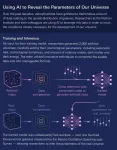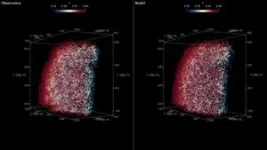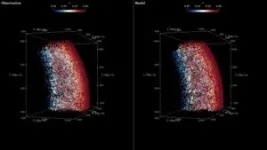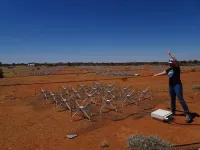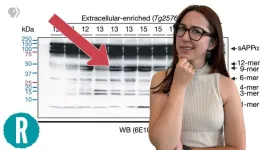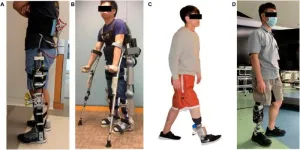(Press-News.org) The standard model of the universe relies on just six numbers. Using a new approach powered by artificial intelligence, researchers at the Flatiron Institute and their colleagues extracted information hidden in the distribution of galaxies to estimate the values of five of these so-called cosmological parameters with incredible precision.
The results were a significant improvement over the values produced by previous methods. Compared to conventional techniques using the same galaxy data, the approach yielded less than half the uncertainty for the parameter describing the clumpiness of the universe’s matter. The AI-powered method also closely agreed with estimates of the cosmological parameters based on observations of other phenomena, such as the universe’s oldest light.
The researchers present their method, the Simulation-Based Inference of Galaxies (or SimBIG), in a series of recent papers, including a new study published August 21 in Nature Astronomy.
Generating tighter constraints on the parameters while using the same data will be crucial to studying everything from the composition of dark matter to the nature of the dark energy driving the universe apart, says study co-author Shirley Ho, a group leader at the Flatiron Institute’s Center for Computational Astrophysics (CCA) in New York City. That’s especially true as new surveys of the cosmos come online over the next few years, she says.
“Each of these surveys costs hundreds of millions to billions of dollars,” Ho says. “The main reason these surveys exist is because we want to understand these cosmological parameters better. So if you think about it in a very practical sense, these parameters are worth tens of millions of dollars each. You want the best analysis you can to extract as much knowledge out of these surveys as possible and push the boundaries of our understanding of the universe.”
The six cosmological parameters describe the amount of ordinary matter, dark matter and dark energy in the universe and the conditions following the Big Bang, such as the opacity of the newborn universe as it cooled and whether mass in the cosmos is spread out or in big clumps. The parameters “are essentially the ‘settings’ of the universe that determine how it operates on the largest scales,” says Liam Parker, co-author of the Nature Astronomy study and a research analyst at the CCA.
One of the most important ways cosmologists calculate the parameters is by studying the clustering of the universe’s galaxies. Previously, these analyses only looked at the large-scale distribution of galaxies.
“We haven’t been able to go down to small scales,” says ChangHoon Hahn, an associate research scholar at Princeton University and lead author of the Nature Astronomy study. “For a couple of years now, we’ve known that there’s additional information there; we just didn’t have a good way of extracting it.”
Hahn proposed a way to leverage AI to extract that small-scale information. His plan had two phases. First, he and his colleagues would train an AI model to determine the values of the cosmological parameters based on the appearance of simulated universes. Then they’d show their model actual galaxy distribution observations.
Hahn, Ho, Parker and their colleagues trained their model by showing it 2,000 box-shaped universes from the CCA-developed Quijote simulation suite, with each universe created using different values for the cosmological parameters. The researchers even made the 2,000 universes appear like data generated by galaxy surveys — including flaws from the atmosphere and the telescopes themselves — to give the model realistic practice. “That’s a large number of simulations, but it’s a manageable amount,” Hahn says. “If you didn’t have the machine learning, you’d need hundreds of thousands.”
By ingesting the simulations, the model learned over time how the values of the cosmological parameters correlate with small-scale differences in the clustering of galaxies, such as the distance between individual pairs of galaxies. SimBIG also learned how to extract information from the bigger-picture arrangement of the universe’s galaxies by looking at three or more galaxies at a time and analyzing the shapes created between them, like long, stretched triangles or squat equilateral triangles.
With the model trained, the researchers presented it with 109,636 real galaxies measured by the Baryon Oscillation Spectroscopic Survey. As they hoped, the model leveraged small-scale and large-scale details in the data to boost the precision of its cosmological parameter estimates. Those estimates were so precise that they were equivalent to a traditional analysis using around four times as many galaxies. That’s important, Ho says, because the universe only has so many galaxies. By getting higher precision with less data, SimBIG can push the limits of what’s possible.
One exciting application of that precision, Hahn says, will be the cosmological crisis known as the Hubble tension. The tension arises from mismatched estimates of the Hubble constant, which describes how quickly everything in the universe is spreading out.
Calculating the Hubble constant requires estimating the universe’s size using ‘cosmic rulers.’ Estimates based on the distance to exploding stars called supernovae in distant galaxies are around 10 percent higher than those based on the spacing of fluctuations in the universe’s oldest light.
New surveys coming online in the next few years will capture more of the universe’s history. Pairing data from those surveys with SimBIG will better reveal the extent of the Hubble tension, and whether the mismatch can be resolved or if it necessitates a revised model of the universe, Hahn says. “If we measure the quantities very precisely and can firmly say that there is a tension, that could reveal new physics about dark energy and the expansion of the universe,” he says.
Hahn, Ho and Parker worked on the Nature Astronomy SimBIG study alongside Michael Eickenberg of the Flatiron Institute’s Center for Computational Mathematics (CCM), Pablo Lemos of the CCA, Chirag Modi of the CCA and the CCM, Bruno Régaldo-Saint Blancard of the CCM, Simons Foundation president David Spergel, Jiamin Hou of the University of Florida, Elena Massara of the University of Waterloo, and Azadeh Moradinezhad Dizgah of the University of Geneva.
ABOUT THE FLATIRON INSTITUTE
The Flatiron Institute is the research division of the Simons Foundation. The institute's mission is to advance scientific research through computational methods, including data analysis, theory, modeling and simulation. The institute's Center for Computational Astrophysics creates new computational frameworks that allow scientists to analyze big astronomical datasets and to understand complex, multi-scale physics in a cosmological context.
END
Astrophysicists use AI to precisely calculate universe’s ‘settings’
The new estimates of the parameters that form the basis of the standard model of cosmology are far more precise than previous approaches using the same galaxy distribution data.
2024-08-26
ELSE PRESS RELEASES FROM THIS DATE:
SETI Institute starts first low frequency search for alien technology in distant galaxies
2024-08-26
August 26, 2024, Mountain View, CA -- The SETI Institute, the Berkeley SETI Research Center and the International Centre for Radio Astronomy Research announced a groundbreaking study using the Murchison Widefield Array (MWA) in Western Australia. Led by Dr. Chenoa Tremblay of the SETI Institute and Prof. Steven Tingay of Curtin University, this research is the first to search for signs of alien technology in galaxies beyond our own, focusing on low radio frequencies (100 MHz). This innovative study used the MWA’s large field of view (FOV), allowing the team to cover about 2,800 galaxies in one observation, of which 1300 we know the distance to. Usually, the search for extraterrestrial ...
Bicycle rolling-stop laws don’t lead to unsafe behavior by riders or motorists, research shows
2024-08-26
CORVALLIS, Ore. – Laws that let bicyclists treat stop signs as yield signs lead neither riders nor motorists to act unsafely, according to a groundbreaking Oregon State University study.
The project by OSU College of Engineering researchers featured a novel experimental technique – linking separate bicycle and motor vehicle simulators – and the findings are important as more and more states consider bicycle rolling-stop legislation, said David Hurwitz, the study’s leader.
“It required fully connecting two independent simulators, running subjects in pairs simultaneously and having each subject interacting with an avatar of the other in a shared virtual ...
How a retracted paper affected the course of Alzheimer’s research (video)
2024-08-26
WASHINGTON, Aug. 26, 2024 — In June 2024, a landmark Alzheimer's research paper was retracted due to fraud allegations. Did we waste billions of dollars and thousands of hours of scientists’ time? Maybe not. There are now two potentially helpful drugs on the market targeting the subject of the paper: amyloid beta. This video breaks down the amyloid-beta hypothesis, the fraud itself and where we go from here.
Reactions is a video series produced by the American Chemical Society and PBS Digital Studios. Subscribe to Reactions and follow us on X, formerly Twitter @ACSReactions.
The American Chemical ...
Genotype Matters: Tailored screening for germline CHEK2 variants
2024-08-26
“In our study, we postulated that these differences were driven by three common low-risk (LR) missense variants: p.I157T, p.S428F, and p.T476M, all of which have a BC odds ratio of <1.4.”
BUFFALO, NY- August 26, 2024 – A new editorial was published in Oncotarget's Volume 15 on July 10, 2024, entitled, “Genotype matters: Personalized screening recommendations for germline CHEK2 variants.”
Recognized as a moderate-risk gene, CHEK2—responsible for encoding the CHK2 protein, ...
Interlimb and intralimb synergy modeling for lower limb assistive devices: Modeling methods and feature selection
2024-08-26
A research paper by scientists at Hainan University proposed FSS-eq2Seq as a 2-stage strategy for gait synergy modeling in lower limb assistive devices to achieve synergic and user-adaptive trajectories that improve human-machine interactions.
The new research paper, published on Jul. 03 in the journal Cyborg and Bionic Systems, indicatedSeq2Seq outperforms LSTM, RNN, and GRU in both interlimb and intralimb synergy modeling. Further, FS significantly improves Seq2Seq’s modeling performance.
The concept of gait synergy provides novel human-machine interfaces and has been applied ...
Darwin’s fear was unjustified: Writing evolutionary history by bridging the gaps
2024-08-26
Fossils are used to reconstruct evolutionary history, but not all animals and plants become fossils and many fossils are destroyed before we can find them (e.g., the rocks that contain the fossils are destroyed by erosion). As a result, the fossil record has gaps and is incomplete, and we’re missing data that we need to reconstruct evolutionary history. Now, a team of sedimentologists and stratigraphers from the Netherlands and the UK examined how this incompleteness influences the reconstruction of evolutionary history. To their surprise, they found that the incompleteness itself is actually not such a big issue. “It’s ...
Trends of heat-related deaths in the US, 1999-2023
2024-08-26
About The Study: This study found that heat-related mortality rates in the U.S. increased between 1999 and 2023, especially during the last 7 years. Although a study using data through 2018 found a downward trend in heat-related mortality in the U.S., this study is the first to our knowledge to demonstrate a reversal of this trend from 2016 to 2023. These results align with site-specific data analyzed in a global study that suggest increases in heat-related mortality. As temperatures continue to rise because of climate change, the recent increasing trend is likely to continue. Local authorities in high-risk areas should consider investing in the expansion of access to hydration centers ...
Transgender students more likely than cisgender peers to seek support from school staff, UW–Madison and NYU study finds
2024-08-26
MADISON – Transgender students are more likely to seek support from school staff and less likely to seek support from their parents when compared to their cisgender peers, according to a new study from researchers at the University of Wisconsin–Madison and New York University.
The study, published in JAMA Pediatrics, found among students who felt depressed or anxious, transgender students were 74% less likely than their cisgender peers to seek help from parents than from adults in schools. It also found transgender students were 25% less likely than cisgender students to seek support from ...
Longitudinal changes in youth mental health from before to during the COVID-19 pandemic
2024-08-26
About The Study: In this longitudinal cohort study of economically and racially diverse U.S. youth, there was evidence of differential susceptibility and resilience for mental health problems during the pandemic that was associated with prepandemic mental health and sociodemographic characteristics. These differences are critical to understand for recovery and may yield novel insights into causes of youth mental health problems.
Corresponding Authors: To contact the corresponding authors, email Courtney ...
Repetitive head impacts and perivascular space volume in former football players
2024-08-26
About The Study: In this cross-sectional cohort study of 170 former football players and 54 unexposed controls, larger perivascular space (PVS) volume was associated with greater exposure to repetitive head impacts (RHI). Additionally, PVS volume was associated with worse performance on cognitive tests. These findings suggest that PVS volume may contribute to the association between exposure to RHI, cognitive impairment, and the development of RHI-associated neurodegeneration.
Corresponding Author: To contact the corresponding ...
LAST 30 PRESS RELEASES:
Receptors in mammary glands make livestock and humans inviting hosts for avian flu
Icy hot plasmas
Treating adults with autism: Maryland Clinical Center offers national blueprint for care after pediatric transition
University of Phoenix College of Doctoral Studies releases white paper on reclaiming control to build workforce resilience
NCCN Summit seeks to improve care for veterans and first responders with cancer from line-of-duty exposure
ERC Consolidator Grant for soft robotics researcher
Dual-action arts and wellbeing program transforms dementia care
The global plastic waste trade contributes to coastal litter in importing countries, study shows
UT Dallas partners with Tech Mahindra on AI innovation
Blinking less could signal the brain is working harder to listen, Concordia study shows
Male bonobos track females’ reproductive cycle to maximize mating success
New report outlines science priorities for human Mars exploration
Want to curb cannabis-related crashes? Don’t forget older adults, study finds
Expectant management vs medication for patent ductus arteriosus in preterm infants
Pew funds 7 new biomedical research collaborations
The ERC selects 349 mid-career researchers for €728 million in Consolidator Grants
ERC Consolidator Grant awarded to CISPA researcher Rayna Dimitrova
Antimicrobial effects of Syzygium aromaticum and Salvadora persica against common peri-implantitis pathogens in vitro
EVs pose no greater risk to pedestrians than conventional vehicles
Modeling microplastic accumulation under the ocean surface
Pompeii offers insights into ancient Roman building technology
University of Utah engineers give a bionic hand a mind of its own
Transient and long-term risks of common physical activities in people with low back pain
Health care contact days in older adults with metastatic cancer
Brain resilience science reshapes psychiatry from treating illness to building strength
An assessment of the antidepressant potential of deramciclane in two animal tests
Pitt and UPMC study finds epigenetic signature of pediatric traumatic brain injury, paves way for precision recovery tools
Brain discovery opens door to earlier detection of metabolic syndrome in women
SwRI-led study provides insight into oscillations in solar flares
Announcing the third cohort of the Hevolution/AFAR new investigator awards in aging biology and geroscience research
[Press-News.org] Astrophysicists use AI to precisely calculate universe’s ‘settings’The new estimates of the parameters that form the basis of the standard model of cosmology are far more precise than previous approaches using the same galaxy distribution data.
